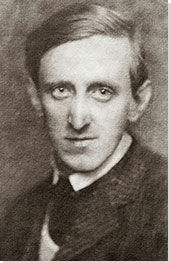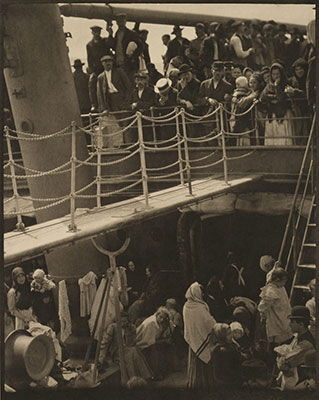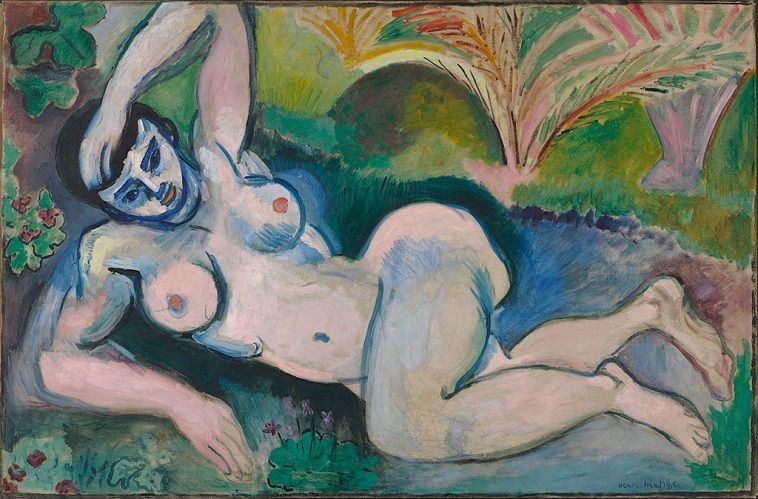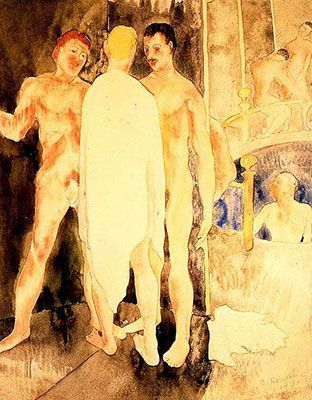Summary of Marsden Hartley
Marsden Hartley, one of the first American artists to paint in a completely abstract mode, was part of the circle of artists, including Georgia O'Keeffe, Arthur Dove, Charles Demuth, and John Marin, who congregated around and were promoted by photographer Alfred Stieglitz. Hartley incorporated into his own paintings the abstract trends that he witnessed first - hand during his time among avant-garde artists in Europe during the 1910s. While his early abstract style met with resistance back in the States, Hartley, undeterred, continued to paint his more recognizable subject matter with the same vivid colors, sharp contrasts, simplified forms, and ambiguous space that he mastered early in his career. His landscape paintings, imbued with the spirit of 19th - century American Transcendentalism, as well as his later portraits, which convey a love for and the earnestness of his subjects, are a uniquely American version of modernism that continue to resonate among younger contemporary artists today.
Accomplishments
- While initially known for his more radical abstractions, Hartley used formal devices, such as strong colors and simplified forms, to convey the weightiness and groundedness of his preferred subjects, whether landscape, portraits, or genre scenes, that created a tension with the two-dimensionality of the picture plane.
- Unlike his colleagues, Hartley spent several extended periods of time away from the United States, living in various parts of Europe as well as Mexico. These experiences exposed him to a much wider swath of avant-garde activity than was available in the U.S. as well as extended encounters with unfamiliar landscapes. One of the results of his travel, however, was an isolation from his fellow artists, which Hartley both welcomed and lamented.
- Not a traditionally religious man, Hartley was steeped in the spiritual ideas of 19th-century Americans Ralph Waldo Emerson, Henry David Thoreau, and Walt Whitman. Additionally, he was drawn to Eastern religions such as Buddhism and Hinduism and was familiar with more esoteric traditions such as Theosophy. Hartley's own syncretic spirituality pervades many of his paintings, especially his landscapes.
- While he rarely discussed his private relationships in public, many now surmise that Hartley had several homosexual relationships throughout his life. At various points, he commemorated these relationships - more subtly in his early painting and more overtly in his later paintings - making Hartley an important early touchstone for gay identity in the United States.
Important Art by Marsden Hartley
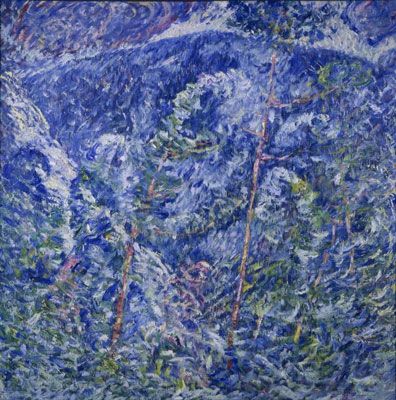
Winter Chaos, Blizzard
The outline of tall brown tree trunks and evergreen branches are barely visible in the flurry of loose brushstrokes that comprise Hartley's Winter Chaos, Blizzard. The shades of blue, pink, and white dabs of color that fill the rest of the canvas show the winter storm that envelops the tree-lined mountain landscape.
This work provides an important example of the Impressionistic style in which Hartley rendered his early landscape scenes; and yet, as noted by historian Gail R. Scott, the approach is distinctly his own and more direct in both subject matter and color application than the "gentle atmospheric snow scenes" of other contemporaneous American artists painting in the Impressionist style. The painting also exhibits what would be a lifelong theme in his work, drawing inspiration from personal experiences with nature; here the rough, stormy winter he experienced in 1908-09 when he lived alone in North Lovell, Maine.
While Hartley quickly moved on from Impressionism, these works garnered him early attention. They were well received when shown in Boston in 1909 and led to dealers Maurice and Charles Prendergast connecting the artist to William Glackens and his group of like - minded artists in New York City with whom Hartley would begin creating early modernist works.
Oil on canvas - Collection of Philadelphia Museum of Art, Philadelphia, Pennsylvania
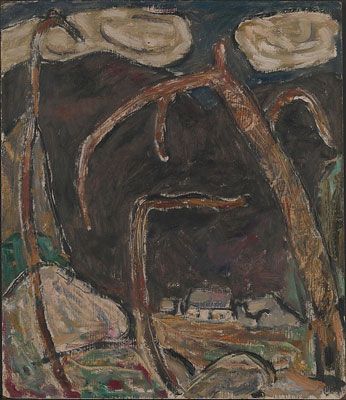
The Dark Mountain No. 1
A large brown mountain occupies two-thirds of the canvas in the background of Hartley's painting. Set under a gray sky and threatening winter storm clouds, a simple one story house is depicted in the center of the painting in front of the mountain. In the foreground is a rocky landscape with barren trees that curve into the center of the composition.
This work is an important example of one of Hartley's earliest series, the Dark Mountain paintings. This work, which is more somber than anything Hartley had created prior, shows the sway of American artist Albert Pinkham Ryder, whose works he saw in 1909 and who he met later that year. Hartley was immediately drawn to Ryder's ability to capture nature in a dramatic way and in response to seeing Ryder's work, he stated, "...it had a sense of realism besides that bore such a force of nature itself as to leave me breathless."
With its monochromatic colors and loose gestural brushstrokes, which Hartley would embrace throughout his career, the artist used the brooding landscape to explore his own emotions. The mood is evocative of loss, even death, and Stieglitz intimated that Hartley was, in fact, having suicidal thoughts at this time.
Oil on composition board - Collection of The Metropolitan Museum of Art, New York, New York
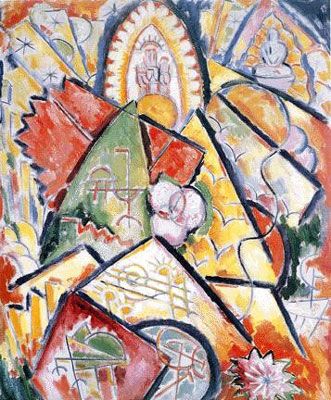
Musical Theme (Oriental Symphony)
Abstract forms in vibrant shades of green, orange, red, and yellow outlined in black lines dominate Hartley's Musical Theme (Oriental Symphony). References to music, such as staffs, clefs, and notes, abound in the painting as does religious imagery, including references to Buddhist and Indian religions as well as mystical symbols such as the eight - pointed star.
Hartley was not a traditionally religious man, but he was steeped in the writings of American Transcendentalists such as Ralph Waldo Emerson and Hendry David Thoreau. Additionally, in 1907 he spent several months at a utopian religious community, Green Acre, in Eliot, Maine, which engaged in comparative studies of world religions and was home to Theosophists and other mystically inclined visitors. Here, Hartley immersed himself in reading and had numerous conversations with the members of Green Acre. His interest in Eastern religions likely began at this point.
The musical references found in this painting are more directly linked to his exposure to artist Wassily Kandinsky and the works of the German Expressionists of the Der Blaue Reiter (Blue Rider Group) during his first European trip in 1912. While Hartley employed musical symbols, we also see him making references to music through the rendering of paint on the canvas as well as taking on an improvisational approach to mark making.
One can also see influences of Picasso's Analytic Cubism in the way Hartley structured his composition. In many ways this immersion in modern European painting helped to advance Hartley's career, yet it would also be the thing that slowed his artistic advancement once he returned to America, where the general public and even many critics were less ready to accept the unfamiliar and distinctly European approach to art.
Oil on canvas - Collection of Rose Art Museum, Brandeis University, Waltham, Massachusetts
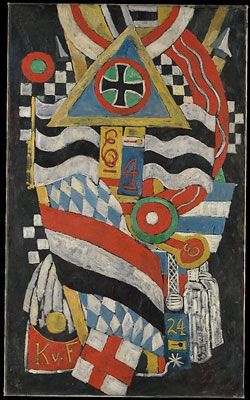
Portrait of a German Officer
Hartley's painting Portrait of a German Officer is replete with diamonds, triangles, circles, black and white lines, and rich shades of red, blue, green, and yellow. Additionally, we see symbols including the Iron Cross and reproductions of German military emblems and flags. The arrangement of these shapes and symbols creates an abstract collage that is at once formally interesting but seems equally mysterious in its meaning. Georgia O'Keeffe commented that Hartley's German paintings were "like a brass band in a closet."
This work is part of one of the most important and best known series of Hartley's career, his so-called German Officer paintings. While showcasing his mastery of Cubism, it is also a key example of how personal experiences helped to shape the themes that Hartley explored in his works. Germany fascinated him from the moment he arrived and, in particular, the military customs and pageantry caught his attention. Intended as a tribute, this painting makes reference to the death of Karl von Freyburg, with whom Hartley had been (believed to be) in love, and who died in battle in October 1914. Hartley later stated that the painting "stood as a symbol for all that is inspiring in young life." The letter "E" stands for von Freyburg's Bavarian Eisenbahn regiment, and "24" his age at death. It was not, however, the subtle references to homosexual love that proved controversial but rather what many felt to be praise Germany and their military action. Hartley's refusal to outright denounce Germany and his continued interest in the country made him a lightning rod for controversy among American audiences and hindered the development of his career.
Importantly, though, Hartley's painting partakes in the modernist rethinking of portraiture that was being carried out by Picasso, Gertrude Stein, and his American colleagues like Charles Demuth and Florine Stettheimer, among others. The painting is roughly the height of a person, emphasizing its human subject. While Hartley did not paint the physical likeness of his deceased friend, the symbols collaged together make an abstract portrait. As art historian Jonathan Frederick Walz has argued, the disappearance of the subject's physical likeness in the portrait points to changing notions of subjectivity in the first decades of the 20th century.
Oil on canvas - Collection of The Metropolitan Museum of Art, New York, New York
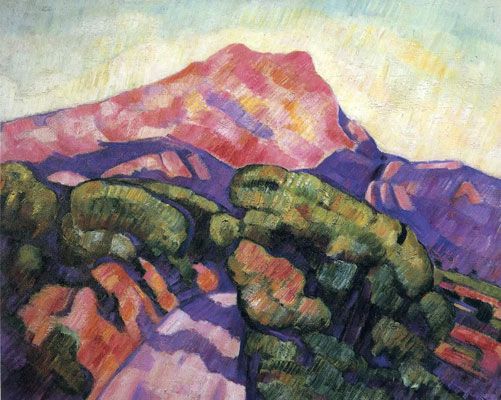
Mount Sainte-Victoire, Aix-en-Provence
Hartley returned to Europe in 1921, and in the late 1920s he lived in southern France, in the province of Aix - en - Provence, where the inimitable Paul Cézanne had lived decades before. Inspired by the landscape and Cézanne's own rendering of it, Hartley depicts Mount Sainte - Victoire in this luscious landscape. In the foreground a tree - lined path leads the viewer's eye to the mountain in the background, which is rendered in bright shades of pink and purple.
Hartley's skill and individuality comes through in his rendering of this familiar mountain range, with more vibrant colors and more delineated forms than Cézanne's. American modernist scholar William Agee in describing Hartley's unique approach states, "They are, to be sure, an act of homage, but the results are startling. The touch is rougher, the image more condensed, the contrasts often sharper than those found in Cézanne; but finally it is the range of hue and the range of light effects that makes these works so original and such marvels of the art of painting."
Here, Hartley shows a rare trait: an artist who can pay tribute to and paint in the style of artists before him without becoming a mere copyist, instead offering a new and, in this case, more modern approach that builds on the work that has come before. Importantly, Hartley was not just looking at Cézanne's paintings but the physical landscape that Cézanne himself saw. Experiencing the landscape personally was crucial to Hartley's paintings. Hartley's earlier thoughts on the New Mexican landscapes that he painted rings true a decade later in France. Hartley stated, "[T]he American painters must first learn to arrive at firsthand contact with it [the landscape]. It shall not come by way of...conventional methods. It is nearer in Cézanne because he sought to establish the quality of reality, the understanding of solidity." In fact, it is that experience of solidity that Hartley wants to capture.
Oil on canvas - Private Collection
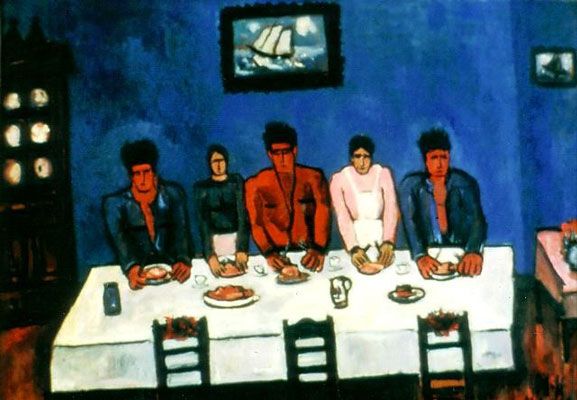
Fishermen's Last Supper
A family portrait, Hartley's painting Fishermen's Last Supper features five people, three large men and two women between them, seated on one side of a long table, facing the viewer. The table is set with food, drink, and a bright white tablecloth that provides a strong contrast to the dark blue wall behind the family. The dining room is a traditional hutch with dishes inside, partially visible on the far left side of the canvas. Two framed paintings of boats at sea hang on the walls, and part of a sideboard is visible on the right.
Hartley frequently explored portraiture later in his career, and the subjects were often people he knew well. Here, Hartley portrays the family of fisherman Francis Mason who he befriended while he was living in Blue Rocks, Nova Scotia. It was with the Masons that Hartley found, albeit briefly, a home and familial connection that filled a void in his often isolated life. The loosely rendered details of the figures and objects signal a sort of faux naïve style of painting that Hartley, the consummate outsider, would continue to explore.
More than a simple group portrait however, it is also a tribute to the family and specifically the two son's Alphonse and Donny who, with a cousin, drowned at sea on September 19, 1936. Having been with the family at the time of the tragedy, Hartley felt the loss deeply, and there was later some speculation of romantic feelings for the sons on the part of the artist to the sons. Hartley never mentioned such feelings, but if true, as with his previous lover Karl von Freyburg, this depiction is magnified by his grief. The artist created two versions of this work; the earlier one is more overt in its acknowledgement of the loss, including eight - pointed stars above the two sons' heads to indicate their death and the inclusion of text written on the tablecloth. However, in this later, refined version, the reference is more subtle with a faint blue halo - like shadow over the two two sons' heads and laurel wreaths placed on two empty chairs opposite them to indicate everlasting life. A writer as well as an artist, Hartley would immortalize the family in an epic poem titled "Cleophas and His Own" (1936) as well as shorter poems.
Oil on board - Private Collection
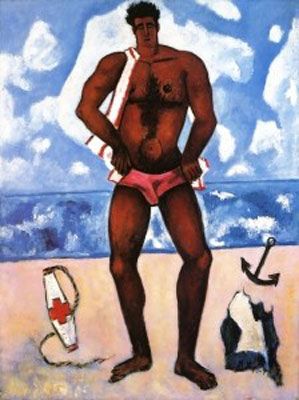
Canuck Yankee Lumberjack at Old Orchard Beach, Maine
Here, Hartley portrays a large man at the beach in a red speedo with a white and red striped towel slung over his right shoulder, which is sharply contrasted to his tanned body. Standing on the sandy beach, his body dominates the painting, filling the entire center of the canvas. Behind him is the water and a blue, cloud-filled sky. Depicted to the left of the figure is a lifeguard floatation device with a red cross painted on it and to the right a rock and in the distance an anchor.
This work demonstrates Hartley's brand of modernism in which objects are rendered in a flat fashion and bold brushstrokes and color choices lend a sense of weightiness to the scene. As a result, the nearly naked figure is granted an overwhelming presence. Hartley's modernist experimentation with notions of space is also present, as the figure seems to push beyond the confines of the canvas. Hartley's figures calls to mind Paul Cézanne's Bather (1885 - 86), and as art historian Gail Scott writes, "Hartley's young lumberjack, like Cézanne's bather, is on a ground plane but not precisely in the landscape. Both come to life through a combination of traditional modeling (which gives weight and volume to the anatomy) and expressive techniques - black outline drawing and flat patches of sky between the bent arms - which in turn defy that weight and compress the figure into ambiguous relationship with ambient space."
While clearly an homage to Cézanne, Hartley's choice of subject is curious. A lumberjack, who one associates with the forest wearing jeans and flannel shirt, is here portrayed in his bathing suit on the beach. As art historian Randall Griffey eloquently describes, "Hartley's decidedly anti-academic, intentionally unrefined technique imbues the figures with an alluring combination of toughness and tenderness, an unconventional sensuality that renders them immediate yet remote." Griffey points out that Hartley daringly exhibited his private homosexual desires at a time when homosexuality was widely policed and criminalized.
Oil on fiberboard - Collection of Hirshhorn Museum and Sculpture Garden, Smithsonian Institution, Washington DC
Biography of Marsden Hartley
Childhood and Education
Edmund Hartley was the youngest of nine children born to English immigrant parents Thomas and Eliza Jane Hartley. The death of his mother when he was eight years old affected him profoundly; many years later, Hartley explained, "I was to know complete isolation from that moment forward." His family was soon after divided, with Hartley forced to live with an older sister in Auburn, Maine. To assuage his loneliness, he found solace in the comforting embrace of nature, something he would cling to throughout his life. Hartley's love of the outdoors also led him to imbibe the writings of American Transcendentalists Ralph Waldo Emerson and Henry David Thoreau in addition to the poetry of Walt Whitman.
Despite having left school at fifteen to work in a shoe manufacturing factory, Hartley's art education began in 1893 after moving to Ohio to live with other siblings and his newly remarried father. He began taking lessons with local artists, and in 1898 he enrolled at the Cleveland School of Art. His skills attracted the attention of a school trustee who gave him a five-year stipend to study art in New York, which commenced in 1899. He studied with William Merritt Chase, and then spent four years at the National Academy of Design. It was during this time that Hartley also met the painter Albert Pinkham Ryder, who would have a profound influence on Hartley's painting.
Early Training
In 1906 Hartley briefly returned to Lewiston, Maine to teach painting, and in an act of reinvention, he took his stepmother's maiden name as his own first name, becoming Marsden Hartley. From the earliest moments of his career, beginning with the summers spent between his years of study, travel was important. Inspiration from the landscape where he lived and the people he met would manifest itself thematically in the subjects of many of his works and he established a pattern of spending periods of time in near isolation in nature followed by stays in cities.
In 1909, Hartley met Alfred Stieglitz in New York City, a meeting that would have significant repercussions for his career. The two quickly became friends, and Stieglitz introduced him to a circle of artists, including Charles Demuth, Arthur Dove, John Marin, and Paul Strand, who were all exploring modern approaches to painting and photography. Stieglitz gave Hartley his first one - man show at the famed 291 Gallery in 1909.
Enjoying the company of other writers and artists that he met in New York, Hartley was often found sitting with them at Kriel's Bakery where he was allowed to eat for free by the sympathetic owner. Despite his lack of funds, Hartley paid attention to his appearance, which fellow artist Alfred Dreymborg noted, stating, "When spring came, if he could afford nothing else, Marsden managed to buy a gardenia for his buttonhole."
After a successful exhibition at 291 in 1912, Hartley set out for Europe and found artistic inspiration and comradery in Paris, where he met famed collector Gertrude Stein and visited her salon. While she purchased four of his works, he was most impressed by the paintings of other artists she owned, including those by Pablo Picasso. Hartley recalled of the Picassos, "they seemed to burn my head off - I felt indeed like a severed head living off itself by mystical evacuation."
It was also in Paris that he met German sculptor Arnold Rönnebeck and his cousin Karl von Freyburg, who was a lieutenant in the Prussian army. The two introduced Hartley to the work and writing of Wassily Kandinsky and the German expressionist group Der Blaue Reiter, which would have profound influence on his art. Hartley quickly began creating works that embraced the expressionistic style of European modernism.
In 1913 he visited Rönnebeck and von Freyburg in Berlin and soon moved there. Many scholars believe that Hartley soon developed a serious romantic relationship with von Freyburg. He became fascinated with the pageantry of the German military uniforms and parades. While German society adhered to strict mores about gender and sexuality, Berlin's bohemian society embraced sexual liberation, and it seems that Hartley in turn found himself at home there. He wrote to Stieglitz, "I have lived rather gayly in the Berlin fashion - with all that implies." Von Freyburg died in battle in October 1914, and Hartley honored his love with a symbolic portrait, Portrait of a German Officer (1914). He continued to paint pictures related to this painting, suggesting he felt the loss of his partner deeply. Fiercely private, little is known of Hartley's relationships. He had friendships with other gay men during his career, including the painter Charles Demuth and the poet Hart Crane but little is known of his romantic attachments.
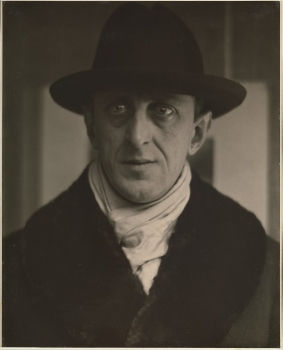
World War I forced Hartley to return to America in 1915. Had he been able to stay in Germany where his modern style was being recognized and accepted, his early career might have fared better and developed more quickly; however, his most recent works shown after his return were not well received. The German-inspired themes made them a hard sell, given the anti-German sentiment of the time. Disheartened at being home, Hartley responded with long periods of travel, including a trip to Bermuda with Charles Demuth in 1917; stays in Maine; and two years in the southwest, including New Mexico and California, where he began a series of works focused on the landscape.
Mature Period
Upon returning to New York City in 1920 he was named first secretary of the Société Anonyme, founded by Katherine Dreier and Marcel Duchamp. Here he also befriended Man Ray and briefly immersed himself in the Dada art and literary culture. Writing, which had long been an interest of his, resulted in the publication of Adventures in the Arts (1921), a collection of essays on artists and vaudeville performances. He would go on to publish other works including his autobiography Somehow a Past (1933).
The key years of Hartley's career were inspired by his numerous travels around Europe and the United States. He moved back to Berlin in November 1921 and began a series of still lifes he would return to periodically. In addition, the landscapes of Italy and France, where he moved in 1925 and lived for three years, are reflected in his paintings. The receipt of a Guggenheim Fellowship, which funded a year of painting outside of the United States, enabled Hartley to travel to Mexico in 1932. Here he was inspired not only by nature but also the mysticism and spiritualism of the Mexican people.
Traveling alone suited the artist's solitary nature, and becoming part of organized institutions proved difficult for him. For instance, when he returned to New York in February 1934, he joined the federal government's Works Progress Administration, but he was not able to abide by the organization's regimented structure. His frequent travels also created a rift between the artist and Stieglitz who decided he would no longer pay for the storage of Hartley's works. In an angered response to this betrayal, the artist chose his fifty-eighth birthday to dramatically burn one hundred of his works to free himself of the financial burden.
Later Period
A major source of inspiration late in Hartley's career was a trip to Blue Rocks, Nova Scotia where he stayed with the Mason family. The landscape, the family dynamic, as well as the tragic death of the family's two sons and a cousin by drowning on September 19, 1936 would appear as themes in many of the artist's later works and marked the beginning of an increased focus on portraiture and still lifes. He would continue to develop these interests in 1941, when after years of travelling, Hartley returned to his home state of Maine. It was during this time that Hartley was able to make the long anticipated trip to Mount Katahdin and create a visual record of his journey.
Despite declining heath, Hartley painted voraciously in these last years in Maine. Of this period he stated, "My work is getting stronger and stronger and more intense all the time... I have such a rush of new energy and notions coming into my head, over my horizon like chariots of fire that all I want is freedom to step aside and execute them." In an ending, similar to much of his life, he died of heart failure quietly and alone.
The Legacy of Marsden Hartley
Marsden Hartley played a key role in ushering in and shaping American modernism in the early-20th century. While he was not alone in this, his unique approach to subject matter, color, and brushstroke that differentiated him from his peers was largely a result of his heavy immersion in European modernism, which he emulated and used as the foundation for his own art. Over the years, Hartley's legacy has been uneven among scholars; first, in part, because of his subject matter of German themes and homosexual innuendo, and second because of the rise of and preference for Regionalism during the latter part of his life.
His reputation, though, gained momentum, and his paintings have influenced contemporary artists. This influence was on exhibit most recently in a 2015 show at New York City's Driscoll Babcock Galleries in which seven contemporary artists - Katherine Bradford, Jennifer Coates, Holly Coulis, Rachael Gorchov, David Humphrey, Danielle Orchard, and Robin F. Williams - who have acknowledged the influence of Hartley in their own work, were asked to create paintings in response to key works by the artist.
Influences and Connections

-
![Alfred Stieglitz]() Alfred Stieglitz
Alfred Stieglitz ![Mabel Dodge Luhan]() Mabel Dodge Luhan
Mabel Dodge Luhan![Paul Rosenberg]() Paul Rosenberg
Paul Rosenberg- Karl von Freyburg
- Hudson Walker
-
![Charles Demuth]() Charles Demuth
Charles Demuth -
![John Marin]() John Marin
John Marin ![Arthur B. Davies]() Arthur B. Davies
Arthur B. Davies- Arnold Rönnebeck
-
![Alfred Stieglitz]() Alfred Stieglitz
Alfred Stieglitz ![Mabel Dodge Luhan]() Mabel Dodge Luhan
Mabel Dodge Luhan![Paul Rosenberg]() Paul Rosenberg
Paul Rosenberg![William Carlos Williams]() William Carlos Williams
William Carlos Williams- Hudson Walker
Useful Resources on Marsden Hartley
- Marsden HartleyOur PickBy Gail R. Scott
- Marsden Hartley: The Biography of an American ArtistBy Townsend Ludington
- Somehow a Past: The Autobiography of Marsden HartleyOur PickBy Marsden Hartley and Susan Elizabeth Ryan
- The Collected Poems of Marsden Hartley, 1904 - 1943By Marsden Hartley and Gail R. Scott
 Ask The Art Story AI
Ask The Art Story AI